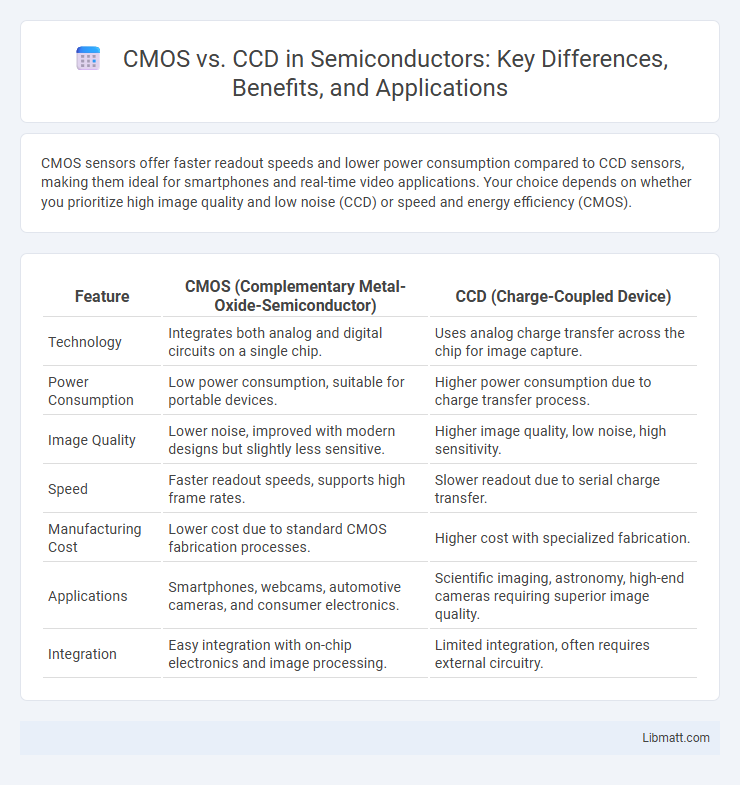CMOS sensors offer faster readout speeds and lower power consumption compared to CCD sensors, making them ideal for smartphones and real-time video applications. Your choice depends on whether you prioritize high image quality and low noise (CCD) or speed and energy efficiency (CMOS).
Table of Comparison
| Feature | CMOS (Complementary Metal-Oxide-Semiconductor) | CCD (Charge-Coupled Device) |
|---|---|---|
| Technology | Integrates both analog and digital circuits on a single chip. | Uses analog charge transfer across the chip for image capture. |
| Power Consumption | Low power consumption, suitable for portable devices. | Higher power consumption due to charge transfer process. |
| Image Quality | Lower noise, improved with modern designs but slightly less sensitive. | Higher image quality, low noise, high sensitivity. |
| Speed | Faster readout speeds, supports high frame rates. | Slower readout due to serial charge transfer. |
| Manufacturing Cost | Lower cost due to standard CMOS fabrication processes. | Higher cost with specialized fabrication. |
| Applications | Smartphones, webcams, automotive cameras, and consumer electronics. | Scientific imaging, astronomy, high-end cameras requiring superior image quality. |
| Integration | Easy integration with on-chip electronics and image processing. | Limited integration, often requires external circuitry. |
Introduction to CMOS and CCD Sensors
CMOS (Complementary Metal-Oxide-Semiconductor) and CCD (Charge-Coupled Device) sensors are essential technologies in digital imaging. CMOS sensors integrate photodiodes and amplifiers on the same chip, enabling faster readout speeds and lower power consumption compared to CCD sensors, which transfer charge across the chip to a single output node for conversion. The choice between CMOS and CCD impacts image quality, noise levels, and application suitability in cameras and imaging devices.
Historical Development of Image Sensors
CMOS image sensors were developed in the 1960s but gained commercial success in the late 1990s, offering lower power consumption and integration with digital circuitry compared to CCD sensors, which were invented earlier in 1969 and dominated the market due to their superior image quality and noise performance. CCD sensors became the standard for high-end imaging applications throughout the 1970s and 1980s, particularly in scientific and professional photography. Your choice between CMOS and CCD may depend on the historical evolution of technology and the specific requirements for image quality, cost, and power efficiency.
How CMOS Sensors Work
CMOS sensors operate by converting light into electrical signals through photodiodes located at each pixel, allowing for individual pixel readout and faster image processing. Unlike CCD sensors, CMOS technology integrates amplifiers and A/D converters on the same chip, enhancing power efficiency and reducing manufacturing costs. Understanding how CMOS sensors function can help you choose the right imaging device for applications requiring speed and low energy consumption.
How CCD Sensors Work
CCD sensors work by converting light into electrical charge through an array of photodiodes. Each photodiode accumulates charge proportional to the light intensity during exposure, which is then transferred sequentially through the sensor to an analog-to-digital converter. This process provides high image quality with low noise, making CCD sensors ideal for applications requiring precise light measurement and superior image resolution.
Key Differences Between CMOS and CCD
CMOS sensors consume less power and offer faster readout speeds compared to CCD sensors, making them ideal for high-speed imaging applications. CCD sensors provide superior image quality with lower noise and higher sensitivity, often used in professional photography and scientific imaging. CMOS technology integrates additional circuitry on-chip, enabling more compact and cost-effective camera designs than CCDs, which require separate processing.
Image Quality Comparison
CMOS sensors typically offer faster readout speeds and lower power consumption but may exhibit higher noise levels compared to CCD sensors, which are known for superior light sensitivity and lower noise, resulting in higher image quality in low-light conditions. CCD sensors provide smoother image tones and better dynamic range, making them ideal for professional photography requiring high fidelity. Your choice should consider the specific application needs, balancing speed and power efficiency with the desired image quality.
Power Consumption and Efficiency
CMOS sensors consume significantly less power compared to CCD sensors due to their on-chip amplification and digital processing capabilities, which enhance overall efficiency. Your device benefits from CMOS technology by extending battery life without compromising image quality, making it ideal for portable applications. CCD sensors, while capable of high-quality imaging, typically require more power and generate more heat, resulting in lower energy efficiency.
Applications in Photography and Videography
CMOS sensors dominate in modern photography and videography due to their lower power consumption, faster readout speeds, and integration capabilities, making them ideal for smartphones, DSLRs, and mirrorless cameras. CCD sensors, known for superior light sensitivity and low noise performance, remain preferred in high-end scientific imaging and professional video production where image quality is critical. The choice between CMOS and CCD significantly impacts dynamic range, frame rate, and overall image fidelity in both still and motion capture applications.
Cost and Manufacturing Considerations
CMOS sensors are generally more cost-effective to manufacture due to their compatibility with standard semiconductor fabrication processes, allowing integration of additional circuitry on the same chip. CCD sensors require specialized manufacturing steps, increasing production complexity and expense, which often results in higher prices. Your choice between CMOS and CCD may hinge on budget constraints and the desired balance between manufacturing efficiency and sensor performance.
Future Trends in Image Sensor Technology
Future trends in image sensor technology highlight a shift towards advanced CMOS sensors due to their lower power consumption, higher integration capabilities, and faster readout speeds compared to CCD sensors. Innovations in CMOS design, such as global shutters and on-chip noise reduction, continue to enhance image quality and performance for applications ranging from smartphones to autonomous vehicles. Your choice of sensor will increasingly depend on specific needs for speed, resolution, and energy efficiency as CMOS technology drives the next generation of imaging solutions.
CMOS vs CCD Infographic

 libmatt.com
libmatt.com